Nano IR Transitional Window Film VS. Porsche IR Thermal Glass
#1
Nano IR Transitional Window Film VS. Porsche IR Thermal Glass
This is also a new product that we now carry - PhotoSync Heat Transitioning Film, which is made by Prestige Film Technologies. Simply put, this window film's (tint) heat rejecting capabilities transform when sun is more intense.
We were the beta testers for the manufacturer for a good 2.5 years now, so we are very familiar with its capabilities...So how does it perform and how it differs from regular tint?
We put it to test to compare it with Porsche factory installed thermal insulated glass. The factory installed option costs $1125 (for rear glasses only) to the Porsche owner.
Here is our test:
Outdoor temperature: 72 degrees
Time during test: 4pm
Product: Spectra PhotoSync45
Shade: 45% VLT (visible light transmission)
IR Rejection: 98.5% IR Rejection at peak performance
Total Solar Energy Rejection: 65%
VS:
Porsche Thermal IR Glass
Shade: 30% VLT (visible light transmission)
**surface temperature measurements taken on passenger seat exposed to window with PhotoSync45 vs. rear seat exposed to window with Porsche Thermal IR Glass
TEST 1
PhotoSync45 measured at 1 Minute 39 seconds 85.6 degrees
Thermal IR Glass measured at the 2 Minute mark 87.8 degrees
Windshield exposed front dash measured at 2 Minute 35 seconds at 101.1 degrees
TEST 2
PhotoSync45 measured at 18 Minutes 52 seconds 86.3 degrees
Thermal IR Glass measured at 18 Minutes 5 seconds 91.4 degrees
Windshield exposed front dash measured at 19 Minute 35 seconds 106.8 degrees
PhotoSync45 Exposed Seat
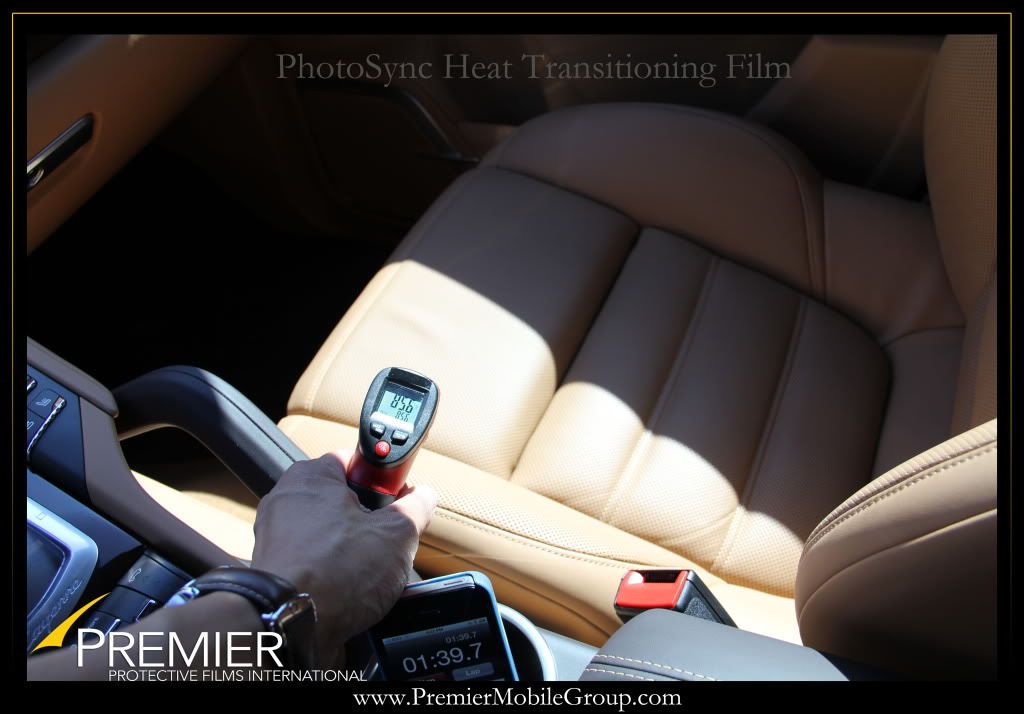
Porsche Thermal IR Glass Exposed Seat
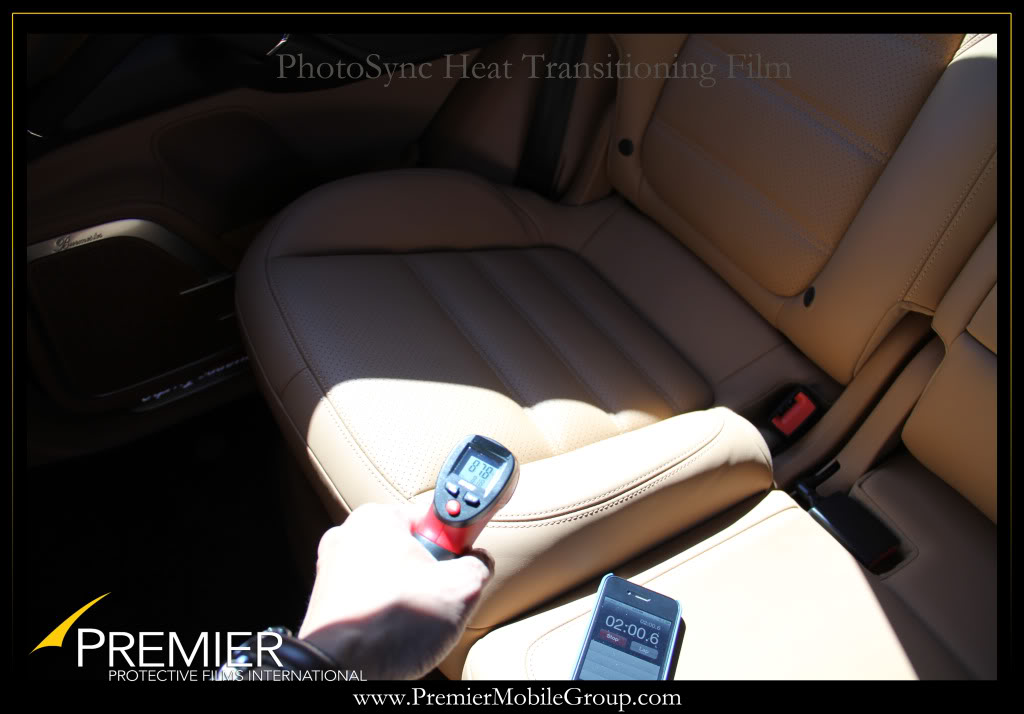
Dash
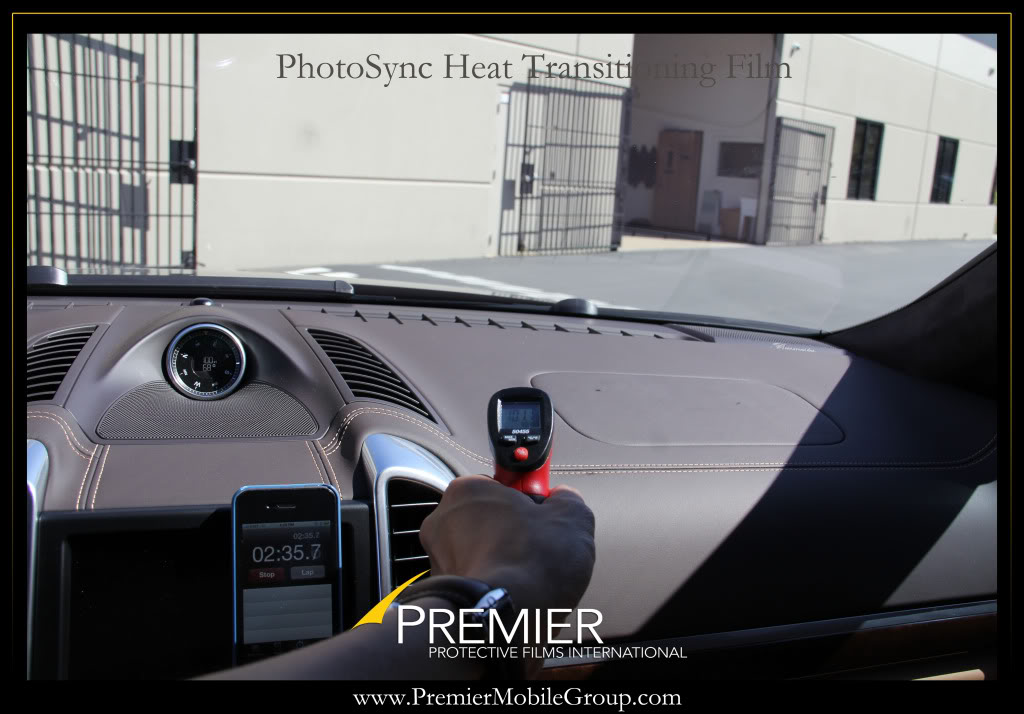
We were the beta testers for the manufacturer for a good 2.5 years now, so we are very familiar with its capabilities...So how does it perform and how it differs from regular tint?
We put it to test to compare it with Porsche factory installed thermal insulated glass. The factory installed option costs $1125 (for rear glasses only) to the Porsche owner.
Here is our test:
Outdoor temperature: 72 degrees
Time during test: 4pm
Product: Spectra PhotoSync45
Shade: 45% VLT (visible light transmission)
IR Rejection: 98.5% IR Rejection at peak performance
Total Solar Energy Rejection: 65%
VS:
Porsche Thermal IR Glass
Shade: 30% VLT (visible light transmission)
**surface temperature measurements taken on passenger seat exposed to window with PhotoSync45 vs. rear seat exposed to window with Porsche Thermal IR Glass
TEST 1
PhotoSync45 measured at 1 Minute 39 seconds 85.6 degrees
Thermal IR Glass measured at the 2 Minute mark 87.8 degrees
Windshield exposed front dash measured at 2 Minute 35 seconds at 101.1 degrees
TEST 2
PhotoSync45 measured at 18 Minutes 52 seconds 86.3 degrees
Thermal IR Glass measured at 18 Minutes 5 seconds 91.4 degrees
Windshield exposed front dash measured at 19 Minute 35 seconds 106.8 degrees
PhotoSync45 Exposed Seat
Porsche Thermal IR Glass Exposed Seat
Dash
#2
TEST 2
PhotoSync45 measured at 18 Minutes 52 seconds 86.3 degrees
Thermal IR Glass measured at 18 Minutes 5 seconds 91.4 degrees
Windshield exposed front dash measured at 19 Minute 35 seconds 106.8 degrees
PhotoSync 45 after 18 Minutes 52 seconds - 86.3 degrees
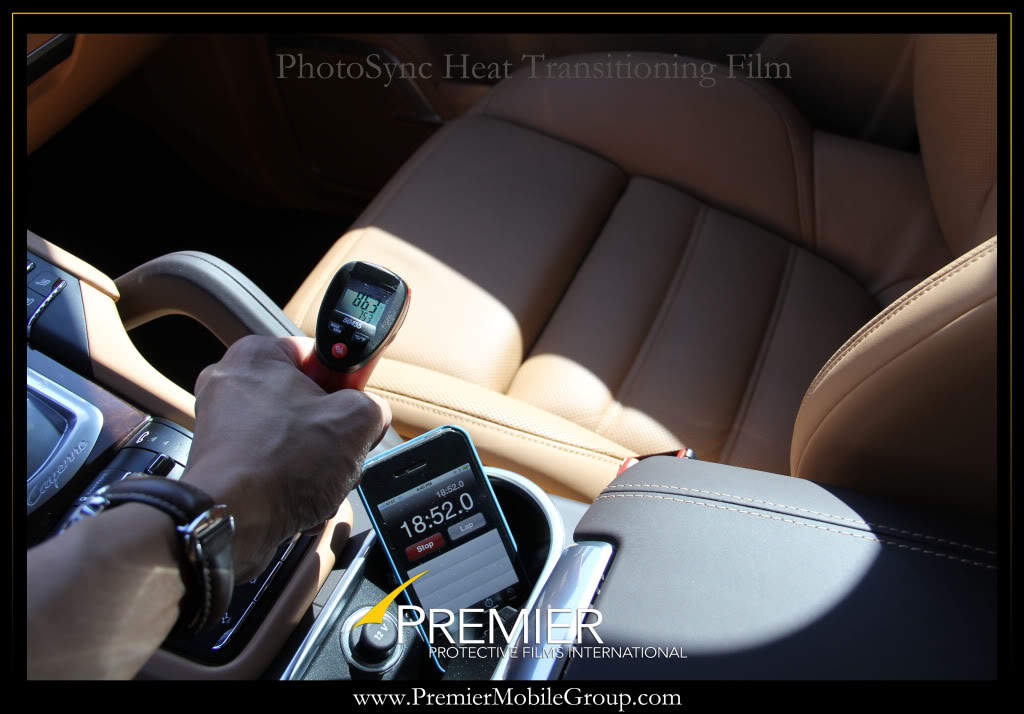
Porsche Thermal IR Glass after 18 Minutes 5 seconds - 91.4 degrees
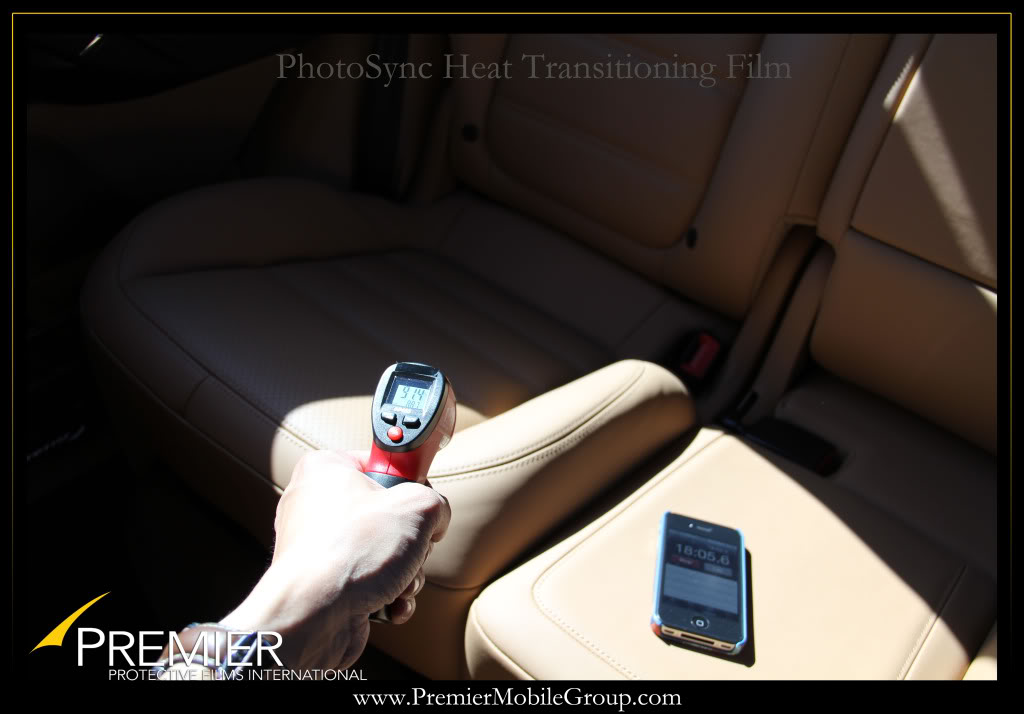
Dash
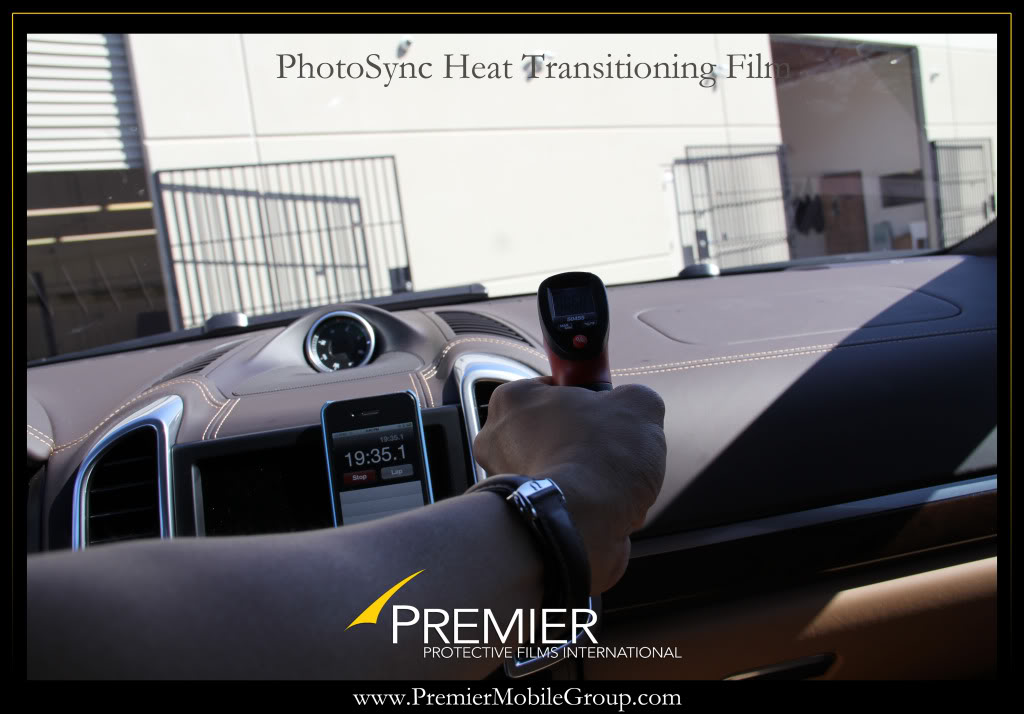
PhotoSync45 measured at 18 Minutes 52 seconds 86.3 degrees
Thermal IR Glass measured at 18 Minutes 5 seconds 91.4 degrees
Windshield exposed front dash measured at 19 Minute 35 seconds 106.8 degrees
PhotoSync 45 after 18 Minutes 52 seconds - 86.3 degrees
Porsche Thermal IR Glass after 18 Minutes 5 seconds - 91.4 degrees
Dash
#3
Here's what PhotoSync45 (45% VLT shade) look from a distance. To compliment its high heat rejection, it also looks quite nice to boot! For those wondering, PhotoSync comes in the following shades (for comparison purposes, OEM glass comes in at 85%-88%):
75%, 65%, 45%
Manufacturer mentioned to us earlier this month that they may be coming out with a 30% some time later this year.
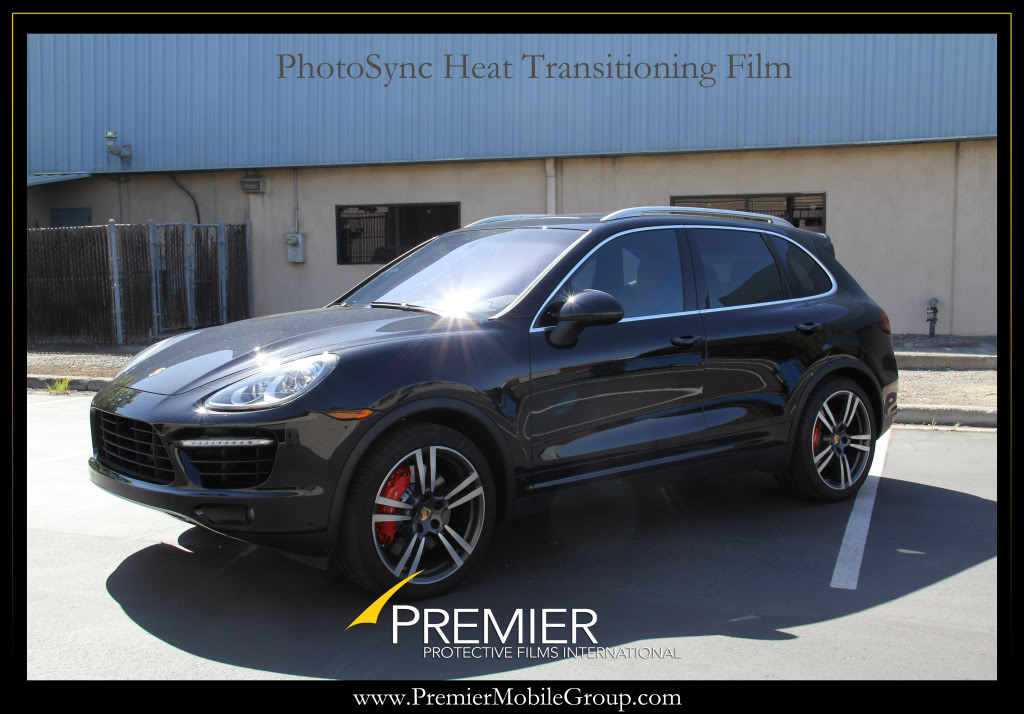
75%, 65%, 45%
Manufacturer mentioned to us earlier this month that they may be coming out with a 30% some time later this year.
#4
The front two windows with PhotoSync45 is not a complete match to Porsche's Thermal IR Glass in the back, but it comes close. Keep in mind PhotoSync45 comes in at 45% while the Porsche glass in the rears came in at 30% - so the Porsche glass is over 15% darker, yet does not perform as well as PhotoSync45

#6
Percentage of window tint always represent VLT (visible light transmission). In short, the higher this percentage the lighter the tint.
#8
As we have all heard, the earth is warming up by approximately 5 degrees since records were kept pre-1900. The hotter regions will get hotter, which means having proper IR and UV protection is important to protecting the interior of vehicles. What we love about PhotoSync is that the performance of it improves as it gets hotter, which at some point reaches as high as 98.5% of infrared rejection. That is quite significant considering that regular tint are typically in the 30% -40% infrared range. With some of the higher end products such as metallics and ceramics, they would only run up as high 75%-85%.
#10
The performance difference between PhotoSync45 (45% shade) vs. Porsche Thermal IR Glass in the rear windows (approximately 30% shade) is quite significant. Below is a simplified version of our test results:
At around the 2 minute mark - PhotoSync45 windows show a 2.2 degree improvement
At 2.35 minute marker, the windshield (no film) dash area registers a surface temperature of 101 degrees
The seats after over 18 minutes of exposure shows that PhotoSync45 registers an improvement of 5.1 degrees
The windshield dash at that time shows a surface temperature of 106 degrees.
Result: Although the exterior temperature does not provide a very compelling difference (it was only 72 degrees), there is an apparent variance between Porsche's IR Thermal Glass and PhotoSync45. Keep in mind the Porsche glass is darker, so less light (approximately 15% less) is entering the cabin in the rear, yet PhotoSync still outperforms it.
At around the 2 minute mark - PhotoSync45 windows show a 2.2 degree improvement
At 2.35 minute marker, the windshield (no film) dash area registers a surface temperature of 101 degrees
The seats after over 18 minutes of exposure shows that PhotoSync45 registers an improvement of 5.1 degrees
The windshield dash at that time shows a surface temperature of 106 degrees.
Result: Although the exterior temperature does not provide a very compelling difference (it was only 72 degrees), there is an apparent variance between Porsche's IR Thermal Glass and PhotoSync45. Keep in mind the Porsche glass is darker, so less light (approximately 15% less) is entering the cabin in the rear, yet PhotoSync still outperforms it.





